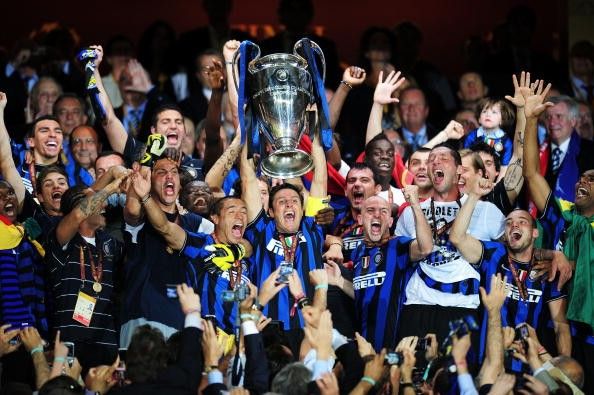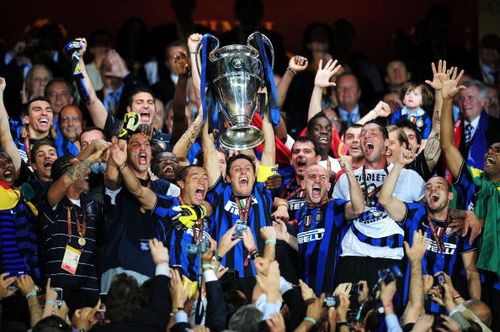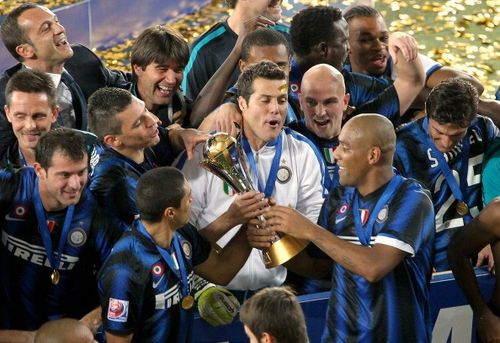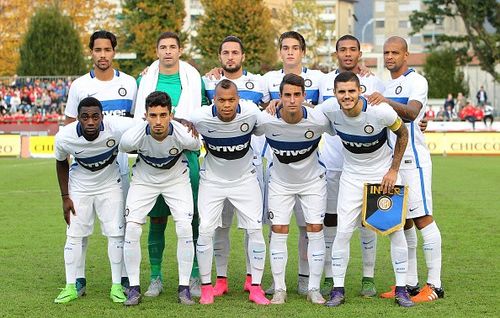
How has Inter Milan's squad changed since the 2010 Champions League win?

The Triumph
Inter Milan had clinched the Champions League crown for the third time in their glorious history having beaten the champions of England, Spain and Germany en route to the coveted trophy in 2010. The Special One Jose Mourinho conquered Europe once again as the Nerazzurri became the first Italian team to win the treble thereby ensuring Italy retain four Champions League places ahead of Germany for the upcoming 2010-11 season.
Inter contested a hard fought 3-2 aggregate victory over Barcelona in the two-legged semi-final tie to reach the final of the premier competition, which was to be played at the Bernabeu in Madrid.
Jose Mourinho fielded a 4-2-3-1 formation against Bayern Munich in the final, with Goran Pandev and Samuel Eto’o on the flanks and ex-Real Madrid midfielder Wesley Sneijder in the hole. Javier Zanetti marshalled the midfield alongside Cambiasso with Christian Chivu deputising as the left-back for the suspended Thiago Motta. Argentine forward Diego Milito was tasked to lead the attack.
From the beginning, the game was touted as a battle between master Louis van Gaal and his protégé Jose Mourinho. The Portuguese served as Louis van Gaal’s assistant at Barcelona, where they won two league titles together.
Mourinho and Van Gaal have very different ideas of football; The Portuguese is often accused of fielding overtly defensive teams who prefer to sit back and hit the opposition on the counter whereas Van Gaal prefers his team to play beautiful football.
Bayern kept their standard shape, a 4-4-2 / 4-2-3-1, with Arjen Robben looking to cut inside from wide areas, and Hamit Altintop occupying a slightly more central position in a similar role on the opposite flank. Strikers Thomas Muller and Ivica Olic looked to break the deadlock in the opening minutes.
Wesley Sneijder played a starring role in the game with his movement behind Milito causing a dearth of problems for opposition centre-halves Martin Demichelis and Daniel van Buyten. Inter were happy to concede possession to Bayern, defended heavily and looked to counter at every opportunity.
Goran Pandev and Samuel Eto’o put in impressive defensive shifts to cancel out Bayern attacks through the flanks while the defensive duo of Zanetti and Cambiasso sat extremely deep and never looked to venture forward in the second half, even when the more attack-minded Dejan Stankovic was brought on.
Inter wanted to protect their 1- 0 lead which came courtesy Diego Milito’s 35th-minute strike, although they managed to do it quite convincingly in the end. The Argentine became the star of the night when he completed his brace in the 70th minute, ensuring a third Champions League win for the Italians.
In the wake of the celebrations, Jose Mourinho announced his imminent departure to take up the managerial post at Real Madrid, citing his desire to become the first manager to win the Champions League with three different sides.
And thus began Inter’s demise.
Post-Mourinho Years
None of the players, who started for the Italian club for the final in Madrid namely Júlio César(GK), Maicon(RB), Lúcio(CB), Walter Samuel(CB), Cristian Chivu (LB), Javier Zanetti (c)(CM), Esteban Cambiasso(CM), Wesley Sneijder(AM), Samuel Eto'o (RF), Diego Milito (CF), and Goran Pandev(LF) remain at the club today. Some of the players have retired while others have moved on to ply their trade elsewhere.
Mourinho’s departure saw Inter Milan cycle through 7 managers in a span of five seasons as the Nerazzurri slumped to a slow demise. Rafael Benítez, Leonardo, Gian Piero Gasperini, Claudio Ranieri, Andrea Stramaccioni, Walter Mazzarri & Roberto Mancini have all occupied the managerial hot seat at the Milanese outfit.
Mourinho’s immediate replacement Rafa Benitez didn't last half a season despite managing to deliver the Club World Cup and the SuperCopa Italiana during his short stint with the club, as the flow of silverware dried up after that.
The constant managerial changes brought instability to the squad as the players never warmed up to a particular philosophy and style of play. Moreover, a lack of activity and ambition in the transfer market only deteriorated the quality of an aging Inter side.
Inter Milan are no longer title contenders and instead seem content with European qualification. Their current squad isn’t one expected to challenge for the League let alone the Champions League for which the Nerazzurri have failed to qualify in 2015-16, after finishing 8th in Serie A in the previous season.
The Financial Fair Play regulations enforced by UEFA in 2011-12 also became a stumbling block for Inter.
In subsequent seasons, the cash-strapped side were forced to sell players and generate funds to attract the likes of Nemanja Vidic and Lukas Podolski, who albeit being stellar names, were well past their prime and were hence offloaded to Inter for cut-price deals by Manchester United and Arsenal respectively.
Other signings of note include Xherdan Shaqiri from Bayern Munich, Gary Medel from Cardiff City and Diego Forlan from Atletico Madrid. Only Vidic and Medel remain in the side today.
Inter in 2015
Under current coach Roberto Mancini, Inter Milan line up in a 4-3-1-2/4-3-3 formation with a pretty consistent starting XI. The Italian has tuned his side in such a manner that the robust athletic abilities of his players make up for a perceived lack in technical talent.
Santon, Miranda, Murillo and Jesus are the preferred defensive unit to shield Samir Handanovic’s goal. The back four are joined by the trio of Guarin, Melo and Kondogbia in the midfield with Perisic in the hole behind Mauro Icardi and Stefan Jovetic up front.
Gary Medel features regularly as a defensive midfielder but can also assume the role of a centre back when required. Adem Ljajic plays as a trequartista while Guarin is best at attacking from a distance. Stevan Jovetic prefers to play through the central lines and tends to drop behind Icardi in a bid to open up alternative passing lanes.
Inter like to cycle possession with short passes in the opposition half and have an average possession of 57.7% this season. In their forays forward, the fullbacks supply numerous crosses into the box for the tall athletic forwards to head home.
Inter’s defence has been susceptible to counter attacks with the back four performing poorly against skilful players. They have a passing accuracy of 85% and attempt just over 14 shots per game. Thus far, Inter have scored eight goals and conceded six in the process.
In short, their results have been better than their performances.
The Nerazzurri sit second in Serie A with 16 points from seven games, 2 points behind league leaders Fiorentina.* Inter will hope to clinch the Serie A this term failing which they would at least hope to feature in Europe after missing out on a chance to do so in their current campaign.
*As of 5th October

